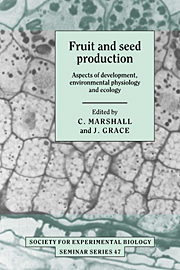Book contents
- Frontmatter
- Contents
- Contributors
- Preface
- Plant reproductive biology: an overview
- The environmental control of reproductive development
- Pollination and fertilization in higher plants
- Embryogenesis
- Environmental and internal regulation of fruiting, with particular reference to Cox's Orange Pippin apple
- Fruit growth and sink strength
- Control of grain growth and development
- The regulation of maternal investment in plants
- Ecological and physiological aspects of reproductive allocation
- Are the distributions of species determined by failure to set seed?
- Edible fruits in a cool climate: the evolution and ecology of endozoochory in the European flora
- Index
Control of grain growth and development
Published online by Cambridge University Press: 04 August 2010
- Frontmatter
- Contents
- Contributors
- Preface
- Plant reproductive biology: an overview
- The environmental control of reproductive development
- Pollination and fertilization in higher plants
- Embryogenesis
- Environmental and internal regulation of fruiting, with particular reference to Cox's Orange Pippin apple
- Fruit growth and sink strength
- Control of grain growth and development
- The regulation of maternal investment in plants
- Ecological and physiological aspects of reproductive allocation
- Are the distributions of species determined by failure to set seed?
- Edible fruits in a cool climate: the evolution and ecology of endozoochory in the European flora
- Index
Summary
Introduction
Seeds contribute on a world basis some 55% of our daily per capita protein and energy supply. Of this, 90% is accounted for by cereals (Duffus & Slaughter, 1980). The contribution is even greater if allowance is made for the inclusion of cereals and other seed crops in the diet of farm animals. It is therefore not surprising that there has long been an interest in the mechanisms regulating seed growth and maturation, since such studies could lead to the identification of key factors involved in the control of yield and quality in the harvested material.
The aim of this chapter is, then, to review present understanding of the control mechanisms involved in seed growth and development. The major emphasis is on the cereals, including barley, wheat, rice, oats and maize. The morphological, physiological and biochemical changes accompanying grain growth and development are described, and the influence of genotype and environmental conditions on these changes is discussed.
Developmental morphology
The cereal seed is surrounded by a seed coat or testa, which is fused to the pericarp, forming a single-seeded fruit known as a caryopsis. The harvested material is termed a grain or kernel; in wheat, rye, triticale, maize, grain sorghum and the naked-grain millets, this consists solely of a caryopsis. In oats, barley, rice and the husked types of sorghum and millet, the grain consists of a caryopsis, together with the lemma and palea, which adhere to the outer surface.
- Type
- Chapter
- Information
- Fruit and Seed ProductionAspects of Development, Environmental Physiology and Ecology, pp. 125 - 150Publisher: Cambridge University PressPrint publication year: 1992
- 1
- Cited by



